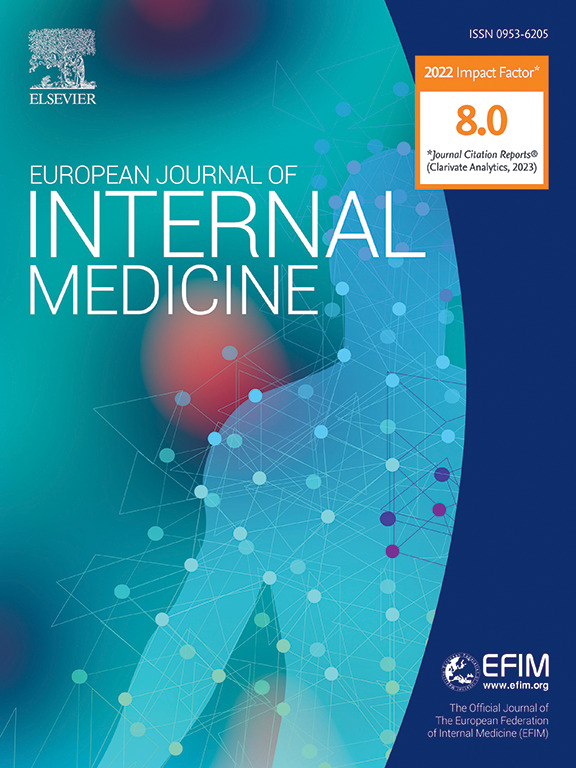射血分数保留型心力衰竭(HFpEF)患者收缩压变化轨迹与预后之间的关系。
IF 5.9
2区 医学
Q1 MEDICINE, GENERAL & INTERNAL
引用次数: 0
摘要
背景:射血分数保留型心力衰竭(HFpEF)患者的最佳收缩压(SBP)仍存在争议。我们旨在评估 HFpEF 患者的收缩压轨迹和预后:根据随访血压,使用潜在类别轨迹模型将醛固酮拮抗剂治疗保留心功能心衰试验(TOPCAT)的患者分为三个SBP轨迹组。主要结果是心血管死亡、心脏骤停和心衰再入院的复合结果。共纳入 3388 名患者(平均年龄 68.6 岁,48.5% 为男性)。在 6 年内,SBP 稳定轨迹组的平均 SBP 保持在 128 mmHg,SBP 下降轨迹组的平均 SBP 从 129 mmHg 下降到 125 mmHg,SBP 上升轨迹组的平均 SBP 从 132 mmHg 上升到 143 mmHg。在平均 3.4 年的随访期间,654 人出现了主要结果。与 SBP 轨迹稳定组相比,SBP 上升轨迹组和 SBP 下降轨迹组的主要和次要结果发生率均较高。经调整后,SBP下降轨迹组与所有结果的风险增加有关(危险比≥1.32),SBP上升轨迹组与全因住院和中风有关(危险比≥1.28):结论:SBP下降或上升轨迹与HFpEF心血管事件的高风险相关,建议SBP轨迹稳定组(≈130 mmHg)的心血管事件发生率和死亡率较低。有必要进行试验以确定 HFpEF 的最佳 SBP。本文章由计算机程序翻译,如有差异,请以英文原文为准。
Association between trajectory of systolic blood pressure and outcomes in heart failure patients with preserved ejection fraction (HFpEF)
Background
The optimal systolic blood pressure (SBP) in heart failure patients with preserved ejection fraction (HFpEF) remains controversial. We aim to assess the SBP trajectory and prognosis in HFpEF.
Methods and Results
Patients from Treatment of Preserved Cardiac Function Heart Failure with an Aldosterone Antagonist Trial (TOPCAT) were classified into three SBP trajectory groups according to the follow-up blood pressure using a latent category trajectory model. The primary outcome was composite of cardiovascular death, cardiac arrest, and hospital readmission for heart failure. A total of 3388 patients (mean age 68.6 years, 48.5 % men) were included. Mean SBP maintained 128 mmHg in the stable SBP trajectory group, declined from 129 to 125 mmHg in the decreasing SBP trajectory group and rose from 132 to 143 mmHg in the increasing SBP trajectory group within 6 years. During a mean follow-up of 3.4 years, 654 individuals had a primary outcome. Incidence for both primary and secondary outcomes were higher in increasing SBP trajectory group and decreasing SBP trajectory group compared with stable SBP trajectory group. After adjustments, the decreasing SBP trajectory group was associated with increased risk of all outcomes (hazard ratio ≥1.32), the increasing SBP trajectory group was associated with all-cause hospitalization and stroke (hazard ratio ≥ 1.28).
Conclusion
The decreasing or increasing SBP trajectory is associated with a high risk of cardiovascular events in HFpEF, suggesting a stable SBP trajectory group (≈130 mmHg) have lower incidence of cardiovascular events and mortality. Trials are necessary to determine the optimal SBP in HFpEF.
求助全文
通过发布文献求助,成功后即可免费获取论文全文。
去求助
来源期刊
CiteScore
9.60
自引率
6.20%
发文量
364
审稿时长
20 days
期刊介绍:
The European Journal of Internal Medicine serves as the official journal of the European Federation of Internal Medicine and is the primary scientific reference for European academic and non-academic internists. It is dedicated to advancing science and practice in internal medicine across Europe. The journal publishes original articles, editorials, reviews, internal medicine flashcards, and other relevant information in the field. Both translational medicine and clinical studies are emphasized. EJIM aspires to be a leading platform for excellent clinical studies, with a focus on enhancing the quality of healthcare in European hospitals.

 求助内容:
求助内容: 应助结果提醒方式:
应助结果提醒方式:


